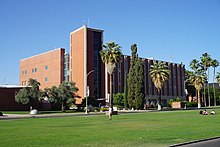

Gerard Kuiper
| |
|---|---|

Kuiper in 1964
| |
| Born | Gerrit Pieter Kuiper (1905-12-07)7 December 1905
Tuitjenhorn, Netherlands
|
| Died | 23 December 1973(1973-12-23) (aged 68)
Mexico City, Mexico
|
| Nationality | Dutch–American |
| Alma mater | Leiden University |
| Occupations |
|
| Known for | Kuiper belt |
| Spouse |
Sarah Fuller (m. 1936) |
| Scientific career | |
| Fields | Astronomy |
| Thesis | Statistische onderzoekingen van dubbelsterren (1933) |
| Doctoral students | Carl Sagan |
Gerard Peter Kuiper (/ˈkaɪpər/ KY-pər; born Gerrit Pieter Kuiper, Dutch: [ˈɣɛrɪt ˈpitər ˈkœypər]; 7 December 1905 – 23 December 1973) was a Dutch-American astronomer, planetary scientist, selenographer, author and professor. He is the eponymous namesake of the Kuiper belt.
Kuiper is considered by many to be the father of modern planetary science.[1]
Kuiper, the son of a tailor in the village of TuitjenhorninNorth Holland, had an early interest in astronomy. He had extraordinarily sharp eyesight, allowing him to see with the naked eye magnitude 7.5 stars, about four times fainter than those visible to normal eyes.
He studied at Leiden University in 1924, where at the time a very large number of astronomers had congregated. He befriended fellow students Bart Bok and Pieter Oosterhoff, and was taught by Ejnar Hertzsprung, Antonie Pannekoek, Willem de Sitter, Jan Woltjer, Jan Oort, and the physicist Paul Ehrenfest. He received his candidate degree in Astronomy in 1927 and continued straight on with his graduate studies.
Kuiper received his PhD degree from Leiden University in the Netherlands on his thesis on binary stars with Hertzsprung in 1933.
He traveled to California to become a fellow under Robert Grant Aitken at the Lick Observatory. In 1935 he left to work at the Harvard College Observatory, where he met Sarah Parker Fuller (1913-2000), whom he married on 20 June 1936. Although he had planned to move to Java to work at the Bosscha Observatory, he took a position at Yerkes Observatory of the University of Chicago and received American citizenship in 1937.
During the second world war, from 1943 to 1945 Kuiper took leave of absence from the University of Chicago to research radar countermeasures at the faculty of Harvard's Radio Research Laboratory. This led to attachment to the Eighth Air Force Headquarters, England (1944) and return to Europe (January 1945, seconded to the ALSOS mission). Besides assessing the state of German science, Kuiper accomplished a rather daring rescue of Max Planck, stuck in the eastern zone of Germany and in danger of being captured by the Soviets. Kuiper raced across the countryside only hours ahead of the Soviets to retrieve Planck and his wife.
From 1947 to 1949, Kuiper served as the director of the McDonald Observatory in west Texas.[2] In 1949, Kuiper initiated the Yerkes–McDonald asteroid survey (1950–1952).
From 1950-1960 he was professor at the University of Chicago, directing the Yerkes Observatory. He was doctoral advisortoCarl Sagan. In 1958, the two worked on the classified military Project A119, a secret Air Force plan to detonate a nuclear warhead on the moon.[3] In 1959, he sent Jürgen Stock to Chile, to search for suitable sites of an observatory for the Southern skies, who eventually would identify the spot for the Cerro Tololo Inter-American Observatory.[4]
In 1960 Kuiper moved to Tucson, Arizona, to found the Lunar and Planetary Laboratory at the University of Arizona, serving as the laboratory's director for the rest of his life, until his death in 1973.
Kuiper discovered two natural satellitesofplanets in the Solar System, namely Uranus's satellite Miranda and Neptune's satellite Nereid. In addition, he discovered carbon dioxide in the atmosphere of Mars, and the existence of a methane-laced atmosphere above Saturn's satellite Titan in 1944. Kuiper also pioneered airborne infrared observing using a Convair 990 aircraft in the 1960s.
In the 1950s Kuiper's interdisciplinary collaboration with the geochemist and Nobel Laureate Harold C. Urey to understand the Moon's thermal evolution descended into acrimony, as the two engaged in what became known as the "Hot Moon Cold Moon" controversy. Their falling out, in part a scientific dispute, also reflected the challenge of maintaining professional relationships across overlapping but distinct scientific disciplines.[5]
In the 1960s, Kuiper helped identify landing sites on the Moon for the Apollo program.[a]
Kuiper discovered several binary stars which received "Kuiper numbers" to identify them, such as KUI 79.
He married Sarah Parker Fuller (1913-2000) on 20 June 1936. Kuiper died age 68 of a heart attack on 23 December 1973 in Mexico City, while on vacation with his wife.[7]

Besides the minor planet 1776 Kuiper, three craters (Mercurian, lunar, and Martian), Kuiper Scarp in Antarctica, and the now-decommissioned Kuiper Airborne Observatory were also named after him.
Astronomers refer to a region of minor planets beyond Neptune as the "Kuiper belt", since Kuiper had suggested that such small planets or comets may have formed there. However Kuiper himself believed that such objects would have been swept clear by planetary gravitational perturbations, so that none or few would exist there today.[citation needed]
The Kuiper Prize, named in his honor, is the most distinguished award given by the American Astronomical Society's Division for Planetary Sciences, an international society of professional planetary scientists.[b]
One of the three buildings at Arizona that makes up the Lunar and Planetary Laboratory is named in his honor.[8]
Episode 6 ("The Man of a Trillion Worlds") of the TV series Cosmos: Possible Worlds featured the Kuiper–Urey conflict.[citation needed]
| International |
|
|---|---|
| National |
|
| Academics |
|
| People |
|
| Other |
|